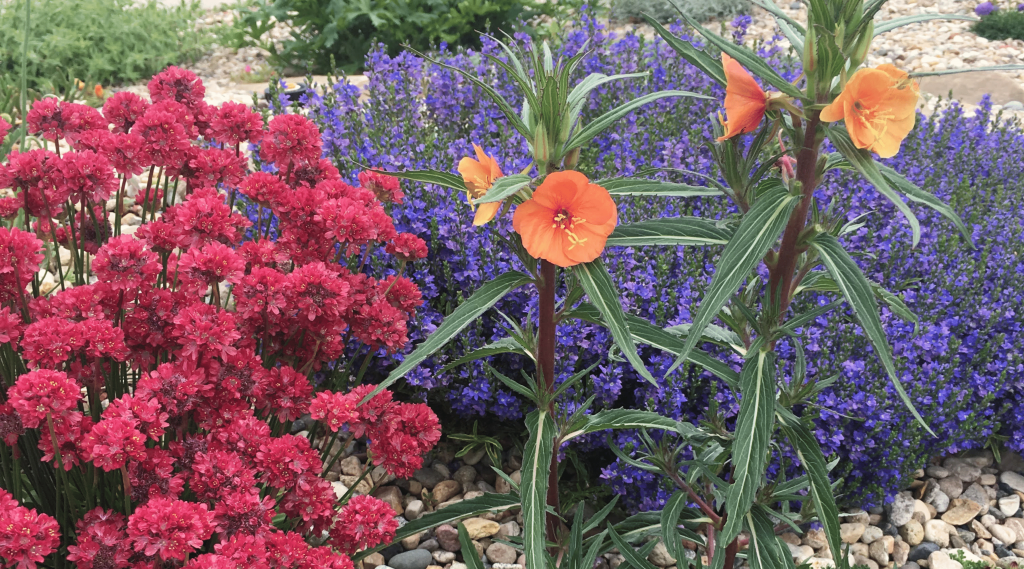Native, Xeric & Edible Plants: The Three Pillars of Plants in our Nursery
Native, Xeric and Edible Plants: The Three Pillars of Plants in our Nursery
Hi there, this is Billy, the nursery manager here at Rick’s Garden Center. We have been very busy preparing to receive this spring’s plant material, and I wanted to take a moment to share our philosophies in plant choice. This is going to be an exciting year for us at the nursery; we’ve been working hard to acquire the toughest, most beautiful, and most unique plants for your garden. You can expect to see more varieties and a wider selection than ever before.
There are three main pillars holding up our plant palette in the nursery. We are highly interested in plants that are either native, xeric, or edible. I’d like to take a moment to explain these three categories, why they’re important, and how they can serve your landscape.
Native Plants
Native plants are most commonly described as a plant that existed in the geographical location prior to European colonization. This may seem pretty cut and dry, but the truth is there is a lot of gray area. There are an incredible amount of eco-regions throughout Colorado, many overlapping, and each with its own set of native plants. It is often debated whether or not cultivars–plants that are cultivated varieties, chosen and grown by people specifically for certain traits–should count as natives at all. Despite these hangups, at Rick’s nursery we believe that native plants can and should be an integral part of every Colorado landscape. Native plants are accustomed to our harsh climate and poor soils in ways that many “exotic” species are not. Native plants also benefit the local ecology in many ways that exotics don’t; since they co-evolved with the local animal population, you can be sure that your plants are serving not only your landscaping interests, but also the wilder Colorado denizens. Some of my favorite native plants are Rabbitbrush (Ericameria nauseosa), Fernbush (Chamaebatiaria millefolium), and Big Bluestem grass (Andropogon gerardii).
Xeric Plants
The word xeric, as in xeriscaping, is derived from the latin word meaning “dry.” These plants, while not necessarily native, are chosen to be as low-maintenance and drought tolerant as possible. Many of them love our nutrient poor, well-draining soils. They can put up with heat exceptionally well, making them good for those tough-to-grow spots in your yard. One common misconception is that “xeriscaping” means removing all the plants from your landscape and filling it with gravel–this method is derided as “zeroscaping” in the landscaping industry. Instead, a wide selection of plants coming together with different colors, textures, and shapes can create a lush, inviting space capable of expressing any number of landscaping styles, from English cottage garden to desert oasis. Some stand-out xeric plants are Dark Knight False Spirea (Caryopteris x clandonensis), Three Leaf Sumac (Rhus trilobata), and Lamb’s Ear (Stachys byzantina).
Edible Plants
Edible plants need the least introduction, and are highly rewarding to grow. There are many types of edible plants that thrive in Colorado, including fruit trees, berry shrubs, and even a few perennial vegetables. Our nursery will carry many varieties of apples, peaches, plums, and cherries this Spring. As for shrubs, my personal favorite Serviceberry (Amelanchier) is a must; we also have many varieties of Raspberries (Rubus idaeus) that are excellent for growing in Colorado. We also have Currants (Ribes), Elderberries (Sambucus) and Grapes available, as well as some other less-known varieties like Seaberries (Hippophae rhamnoides) and Goji Berries (Lycium barbarum). Rhubarb and Asparagus are staple perennial vegetables, and exceptionally easy to grow. There is an edible plant for every space of your landscape.
And Others!
Of course, there are many plants that fit outside these categories that you’ll find at Rick’s nursery. Even though we’re dedicated to native, xeric, and edible plants, we’ll still have your old time favorites like Roses, Hydrangeas, and Hostas.
Thank you for reading! We hope to see you when our nursery reopens on April 15th. Happy planting!

Back to Blog